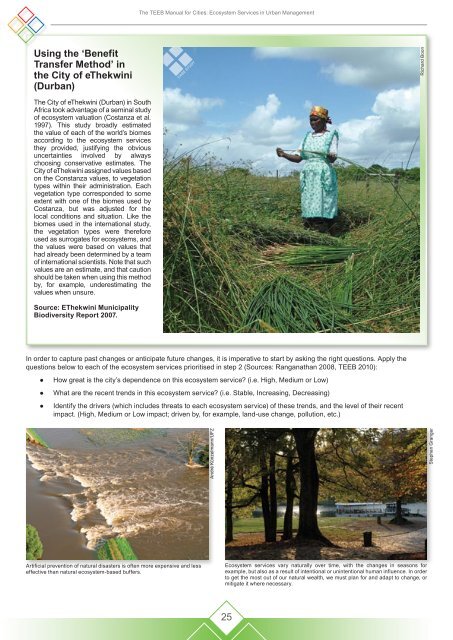TEEB Manual for Cities
TEEB Manual for Cities
TEEB Manual for Cities
Create successful ePaper yourself
Turn your PDF publications into a flip-book with our unique Google optimized e-Paper software.
The <strong>TEEB</strong> <strong>Manual</strong> <strong>for</strong> <strong>Cities</strong>: Ecosystem Services in Urban ManagementUsing the ‘BenefitTransfer Method’ inthe City of eThekwini(Durban)Richard BoonThe City of eThekwini (Durban) in SouthAfrica took advantage of a seminal studyof ecosystem valuation (Costanza et al.1997). This study broadly estimatedthe value of each of the world’s biomesaccording to the ecosystem servicesthey provided, justifying the obviousuncertainties involved by alwayschoosing conservative estimates. TheCity of eThekwini assigned values basedon the Constanza values, to vegetationtypes within their administration. Eachvegetation type corresponded to someextent with one of the biomes used byCostanza, but was adjusted <strong>for</strong> thelocal conditions and situation. Like thebiomes used in the international study,the vegetation types were there<strong>for</strong>eused as surrogates <strong>for</strong> ecosystems, andthe values were based on values thathad already been determined by a teamof international scientists. Note that suchvalues are an estimate, and that cautionshould be taken when using this methodby, <strong>for</strong> example, underestimating thevalues when unsure.Source: EThekwini MunicipalityBiodiversity Report 2007.In order to capture past changes or anticipate future changes, it is imperative to start by asking the right questions. Apply thequestions below to each of the ecosystem services prioritised in step 2 (Sources: Ranganathan 2008, <strong>TEEB</strong> 2010):●●●How great is the city’s dependence on this ecosystem service? (i.e. High, Medium or Low)What are the recent trends in this ecosystem service? (i.e. Stable, Increasing, Decreasing)Identify the drivers (which includes threats to each ecosystem service) of these trends, and the level of their recentimpact. (High, Medium or Low impact; driven by, <strong>for</strong> example, land-use change, pollution, etc.)André Künzelmann/UFZStephen GrangerArtificial prevention of natural disasters is often more expensive and lesseffective than natural ecosystem-based buffers.Ecosystem services vary naturally over time, with the changes in seasons <strong>for</strong>example, but also as a result of intentional or unintentional human influence. In orderto get the most out of our natural wealth, we must plan <strong>for</strong> and adapt to change, ormitigate it where necessary.25
















